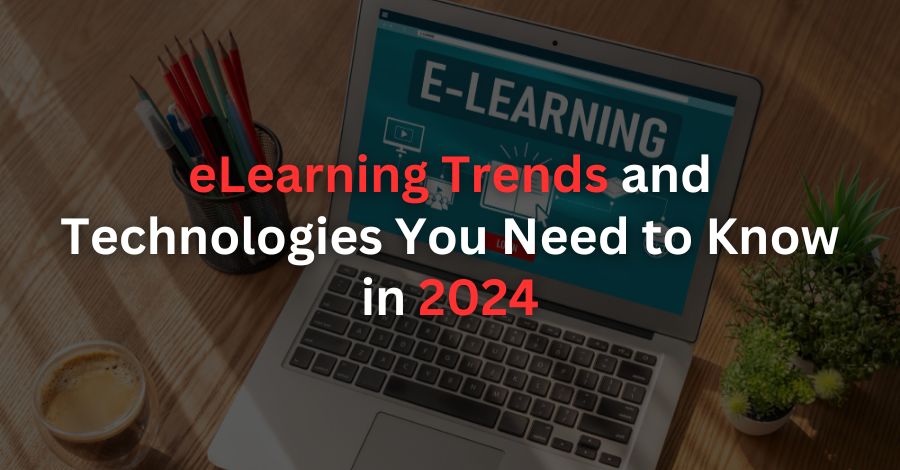Introduction:
The world of learning is undergoing a rapid transformation fueled by cutting-edge eLearning trends. We will discover how these innovations, in particular, enhance engagement, personalization, and basically the overall learning experience for students and professionals alike.
Whether you’re a learner seeking new skills, an educator looking for new tools, or simply curious about the future of education, this blog has something for you. Let’s now explore the latest advancements in elearning, focusing on how they’re shaping the future of education in a big form.
Emerging eLearning Trends in Online Education
| Emerging Trends in Online Education | Description |
|---|---|
| Personalized Learning Paths | Education is customized to fit the unique strengths, interests, and pace of each learner, providing a personalized journey akin to having a dedicated mentor who understands your individual needs. |
| Gamification and Interactive Content | Learning is transformed into an interactive adventure by incorporating game-like elements such as quizzes, puzzles, simulations, and rewards, making education more engaging, enjoyable, and motivating. |
| Adaptive Learning Technologies | AI-powered systems analyze student data to dynamically adjust learning content, pace, and difficulty levels based on individual performance and preferences, providing personalized guidance and support tailored to each learner’s needs. |
| Microlearning and Bite-sized Content | Educational content is delivered in bite-sized, easily digestible portions, allowing learners to absorb knowledge in short, focused bursts, perfect for busy schedules and accommodating short attention spans. |
| Collaborative Learning Platforms | Virtual environments facilitate collaborative learning experiences, enabling students to interact, share ideas, work on projects together, and learn from each other, fostering teamwork, communication skills, and a sense of community among learners. |
Leveraging New Technologies
a. AI and Machine Learning:
Artificial intelligence (AI) and machine learning are are at the forefront of eLearning trends, revolutionizing e-learning by using the power of data analysis to personalize the learning experience in a really big practice. These technologies dive into vast collections of data to interpret each student’s existing unique learning style, strengths, weaknesses, and patterns, which makes it quite effective.
AI-powered platforms can provide tailored recommendations, adaptive quizzes, and even real-time tutoring assistance by understanding individual learning behaviours in a major way. Imagine having a digital mentor specifically by your side, constantly analysing your progress and guiding you with personalized suggestions and support. Whether you’re struggling with a concept or willing to delve deeper into a topic, AI ensures that your learning journey is really optimized for success every step of the way on a really big track of education.
b. Virtual and Augmented Reality:
Step into a world where the lines between reality and imagination blur with virtual and augmented reality (VR/AR) in e-learning. With VR, students can completely exceed physical limitations and engage themselves in extremely compelling virtual environments. The possibilities are endless, from exploring ancient civilizations to conducting virtual experiments or simulations. On the other hand, AR enhances the real world with digital overlays, allowing the students to interact with 3D models, visualize complex concepts, and gain a deeper understanding of abstract ideas. It’s similar to opening a gateway to boundless exploration and discovery, where the constraints of physical space and time dissolve, and the imagination takes flight.
c. Mobile Learning Platforms:
Mobile learning platforms are emerging as a major force in eLearning trends. They provide complete access to educational content anytime, anywhere, using smartphones and tablets, which is extremely transformational. With the presence of mobile devices, learners can now fully engage in learning activities on the go, whether traveling to work, waiting in line, or relaxing at home. Mobile learning offers complete flexibility and convenience, enabling students to personalize their learning experience and fit it into their busy schedules in a subtle way. It’s like carrying a virtual classroom in your pocket, that’s allowing you to learn anything you want whenever inspiration strikes, turning any moment into an efficient opportunity for growth and discovery in no time.
d. Blockchain Technology:
Emerging eLearning trends include the transformative power of blockchain technology. by providing essentially secure and extremely transparent record-keeping for academic credentials and certifications. With blockchain, educational institutions can securely store and entirely verify student credentials, ensuring authenticity and preventing fraud. Additionally, blockchain enables learners to have ownership and control over their legal academic records, allowing for seamless transferability and recognition of credentials across institutions and borders in a big manner. It’s like having a digital passport for your education, providing a tamper-proof and decentralized system for verifying and sharing your definite academic achievements.
Best Practices for Online Teaching
| Practice | Description |
|---|---|
| Engaging Students Remotely | In the digital domain, engagement is crucial for maintaining student focus and motivation. Teachers can utilize multimedia, interactive discussions, and collaborative projects to create dynamic learning experiences. Educators can make virtual classrooms feel as vibrant and interactive as physical by promoting a sense of community and active participation. |
| Assessment and Feedback Mechanisms | Effective assessment and feedback are vital for measuring student progress and guiding their learning journey. Elearning platforms offer various tools, including automated quizzes, peer evaluations, video feedback, and real-time analytics. By providing timely and constructive feedback, educators empower students to reflect on their performance, set improvement goals, and take ownership of their learning. |
| Clear Communication Channels | Establish clear communication channels between students and teachers, ensuring easy access to course materials, instructions, and support. Utilize messaging platforms, discussion forums, and email to facilitate open communication and address student queries promptly. |
| Encourage Active Learning | Encourage active learning through interactive activities, case studies, and problem-solving exercises. Promote student engagement by incorporating polls, quizzes, and group discussions into lessons. Active participation fosters deeper understanding and retention of course content. |
| Provide Flexibility and Accessibility | Recognize the diverse needs and circumstances of students by providing flexible learning options and accessible course materials. Offer recorded lectures, transcripts, and captioned videos to accommodate different learning preferences and accessibility requirements. |
| Foster Collaboration and Peer Learning | Foster collaboration and peer learning through group projects, peer reviews, and online study groups. Encourage students to share ideas, collaborate on assignments, and provide constructive feedback to their peers. Collaboration enhances critical thinking skills and promotes a sense of community among learners. |
| Cultivate a Positive Learning Environment | Cultivate a positive learning environment by fostering a supportive and inclusive classroom culture. Create opportunities for student interaction, celebrate achievements, and provide encouragement and support to learners. A positive learning environment enhances student engagement, motivation, and overall satisfaction with the online learning experience. |
Conclusion:
The ever-developing landscape of education presents exceptional opportunities for development and innovation. As eLearning trends emerge and reshape learning, personalized educational paths and AI-driven coaching are set to revolutionize the way we acquire knowledge, By embracing these advancements with an open mind and staying informed, we can craft a brighter, learner-centric future for education in our digital world.

